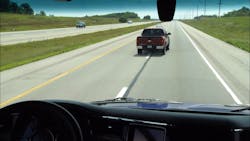Bendix: FMCSA extends exemption for safety technologies
Bendix Commercial Vehicle Systems announced it has received a regulatory two-year exemption extension for the video camera component of its Bendix Wingman Fusion collision mitigation technology and AutoVue Lane Departure Warning (LDW) System.
In its decision granting Bendix’s request for exemption from certain windshield clearance rules, the Federal Motor Carrier Safety Administration (FMCSA) cited highway safety and the benefits of LDW technology, as well as its belief that collision mitigation technologies will offer similar benefits, according to the company. The exemption – which took effect Nov. 18, 2015 – allows fleets and drivers to continue installing and using Wingman Fusion and AutoVue while remaining within FMCSA regulations. The new two-year exemption period expires on Nov. 17, 2017, Bendix said.
AutoVue is a vision-based system linking a camera with a 60-degree field of view to an on-board computer that uses image recognition software to track visible lane markings. The system continually monitors a vehicle’s position and detects when the vehicle begins to drift toward an unintended lane change. Upon detection, AutoVue emits a distinctive “rumble strip” or other audible warning to alert the driver to make a correction.
“Launched this year, Wingman Fusion integrates next-generation advanced safety technologies (radar, camera, brakes, and SafetyDirect by Bendix CVS) into a comprehensive driver assistance system that includes adaptive cruise control, lane departure warning, collision mitigation, and overspeed alert and action,” Bendix said. “By combining the camera data with input from radar and the vehicle’s brake sensors, Wingman Fusion creates a highly detailed and accurate data picture of a vehicle’s situation and surroundings. The camera is powered by the Mobileye System-on-Chip EyeQ processor with state-of-the-art vision algorithms.”
Under the FMCSA prohibitions on obstructions to a driver’s field of view, devices such as antennas or transponders that are mounted at the top of a windshield must be located outside the area swept by the windshield wipers. The exemption covering the camera component of Wingman Fusion and AutoVue states that motor carriers using lane departure warning systems and collision mitigation systems can mount sensors no larger than 2 inches by 3.5 inches within that area, though not more than 2 inches below its upper edge, and outside the driver’s sight lines to the road, highway signs, and signals.
“This extension means Bendix customers can continue to rest assured that a properly mounted Wingman® Fusion™ or AutoVue camera will not constitute a violation, which may affect a fleet’s CSA BASIC score during roadside inspections,” said Fred Andersky, Bendix director of customer solutions – Controls Group. “As use of these types of driver assistance technologies continue to grow, it is possible this exemption could become permanent before Bendix would seek another extension.”
